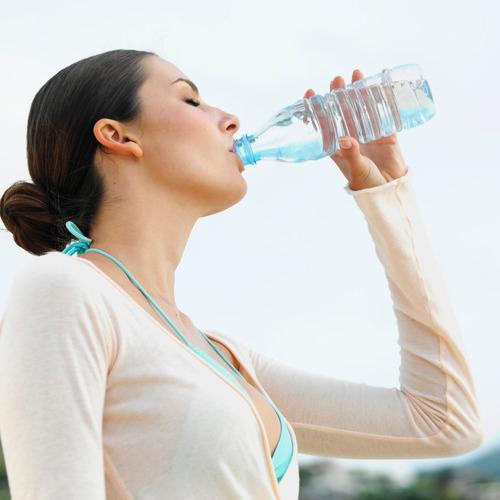
Hydration isn’t as simple as just adding water; Women have a special set of requirements.
By Berne Broudy
When you work out, you sweat: That’s true no matter what your age, sex, or fitness level. Sweating is critical to keeping your body temp regulated, but with each drop of perspiration, you’re losing essential electrolytes and fluids that ensure your bod functions
at its best. Lose too much and you may start to feel tired, dizzy, lightheaded, and achy. That’s dehydration.
Turns out, combating those fluid losses may not be a one-size-fits-all proposition. Female physiology shifts with the monthly changes in estrogen and progesterone levels, and those fluctuations have an impact on our ability to hydrate. Plus, research shows that when women drink fluids according to the standard recommendations, they may not reach peak performance—probably because many of those recommendations were developed from tests on college-age guys. Who knew!
The Female Factor
“Women are not small men,” says Stacy Sims, Ph.D., exercise physiologist–nutrition scientist. “They’re five times more likely than men to have GI problems when exercising, whether it’s bloating or gas or diarrhea. Women are also more likely to suffer from heat exhaustion and heat stroke.”
It all has to do with blood volume, says Sims, and for optimum performance, it’s ideal to keep it high. When a woman’s estrogen and progesterone levels are high (during the luteal, or premenstrual, phase of her cycle), she loses around 8 percent of plasma volume—the watery part of the blood. The high progesterone also causes a resting rise in core body temperature of about 0.9°F, which can shorten the time it takes her to fatigue (and decrease her heat tolerance).
Sodium levels are also key, because that’s what helps transport water into the blood, but those elevated progesterone levels make this harder: Progesterone fights for the same receptors as aldosterone (the hormone responsible for excreting sodium), which increases the amount of sodium your body kicks out.
And if you’re on the Pill or other hormonal birth control? The estrogen and progesterone in your system can be as much as six to eight times higher.
Sip Smarter
Most of these female-specific fluctuations can be balanced and with the right hydration and smart eating, says Sims. Compared with men, women are more likely to need more sodium—as well as potassium, which works with sodium to get water into our blood—and different sugars to properly rehydrate. Glucose and sucrose are the easiest for us to digest; fructose often causes bloating because the female body has trouble metabolizing it as efficiently.
Start thinking about drinking before your workout. “Try to go into an exercise session feeling hydrated,” says Sims. If you’re gearing up for a high-intensity or endurance-based effort, pre-hydration (filling up anywhere from a few to 24 hours before) is crucial to help increase the sodium balance in your body. Then keep it in check by sipping throughout your workout. The American College of Sports Medicine recommends drinking three to eight ounces of a sports drink every 15 to 20 minutes for workouts longer than 60 minutes, but Sims says it should be based on your body weight. (She suggests five to six milliliters per pound of body weight per hour—the lower end for cool conditions, the upper for warmer temps.)
"That’s a general starting point," says Sims. "It’s personal. If you’re working out for 45 minutes or less, it’s important to drink before and after, but hydration during exercise is not needed unless you’re low on body water to begin with—say, at the end of the day or when you’ve first woken up."
According to Sims, the best hydrator during intense or lengthy sweat sessions is a solution made up of water, a small amount of sodium, and a combination of sucrose and glucose—this formula is most effective at transporting water into the blood.
To help improve your power output and endurance, as well as avoid premenstrual-performance decline, use a mix that’s lower in carbs and higher in sodium than the gender-neutral recommendations. For a DIY version, Sims suggests mixing a pinch of iodized table salt and a dash of maple syrup into your water (or you can also find powdered drink mixes like the line she formulated, Osmo Nutrition).
The bottom line: Woman up when you hydrate and you’ll be able to push through your workout, no matter how intense.
Recover Faster
Hydration isn’t the only thing that’s different for women and men when it comes to exercise.
"Women can become overtrained if we work out too intensely at different phases of our cycle," says Sims. "In the second half of our cycle, high blood-hormone concentrations after exercise can make us particularly vulnerable to breaking down muscle and storing fat, which can affect the female body the same way extreme stress can. If you have sore muscles, a high heart rate, moodiness, and lack of appetite, then back off and eat more protein." Have a snack with the right ratio of protein to carbs (about three to one) 30 minutes after exercise, which will help reduce fat storage and increase muscle synthesis. Try six ounces of low-fat Greek yogurt with one tablespoon of honey, half a bagel with lox and avocado, or 12 ounces of low-fat chocolate milk.
Facebook Comment Here
No comments:
Post a Comment
Finish Reading ? Make Your Comment Now..!